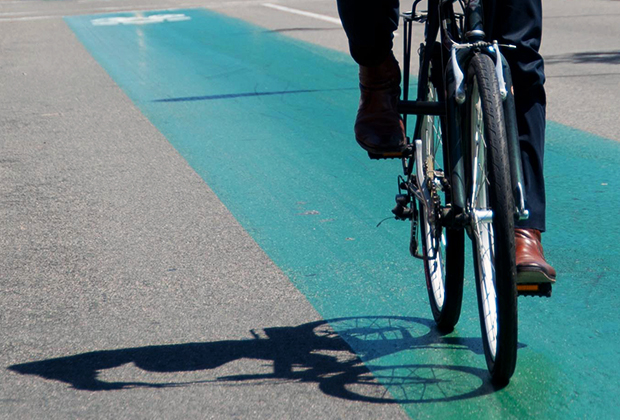First brought to Long Beach in 2009 and most recently installed in Oakland, the Federal Highway Administration (FHWA) has discontinued the use of “super sharrows,” the green bike lanes that are shared with regular traffic, as well as green-backed sharrows.
The super sharrow—or some call “green carpets”—are like the ones found in Belmont Shore to this day: giant green stripes painted along the entirety of a traffic lane to emphasize that the road is to be shared. Green-backed sharrows—like those installed in San Francisco—use green squares along a path that is typically bike-heavy.
In an opinion piece, the California Bicycle Coalition (CBC)—though dissenting against the ban on green-backed sharrows—applauded the ban of super sharrows, noting that there was confusion between both rider and driver as to who could be in the lane and noted that Oakland’s super sharrows are installed “on busy streets with 35MPH traffic.”
Since the treatment on 2nd Street, riding has doubled with sidewalk bicycling and vehicle-related traffic accidents decreasing. In succinct terms, an entire success.
That criticism, however, doesn’t apply to Long Beach: 2nd Street in the Shore can hardly be characterized as a fast lane. With 14 of the 15 intersections having stop lights—that’s one every block for a good mile stretch—the point of the 2nd Street sharrows was not to provide bicyclists with a speedway but to introduce the concept of sharing the road while removing bicyclists from the door zone and impeding on foot traffic along sidewalks.
“With the signals timed to privilege residents and customers—not commuters,” said bicycling advocate and former City of Long Beach Mobility Coordinator Charlie Gandy. “I can run faster than a platoon of cars through this area. And at rush hour it is no contest.”
Since the treatment on 2nd Street, riding has doubled with sidewalk bicycling and vehicle-related traffic accidents decreasing. In succinct terms, an entire success.
For the two and a half years prior to the sharrow being installed—2007 to mid-2009—Belmont Shore had over 90 crashes of which nine involved bikes and two involved a pedestrian. Following the sharrow’s completion on June 25, 2009, there was a drop in overall collisions in 2010 and 2011—33 and 27 respectively—but a spike in bicyclist—4 and 6—as well as pedestrian collisions in 2011 with 3. Then it drops for 2012 drastically, with just 12 collisions overall and no bicyclist/ped-involved collisions.
This isn’t to say that sharrows have always worked well. One but has to look towards our neighbor to the north to see the opposite of Long Beach’s success.
Even further, new markings always cause confusion. This is why we educate both drivers and bicyclists as to what they are—a point to which Cleave Law, a local bike advocate, noted when he saw a failed morning news program in 2009 wrongfully label the sharrows as “bike only” lanes.
“I kept thinking about the missed opportunity we had where someone could have definitively said in front of thousands—possibly hundreds of thousands—of SoCal viewers that the green lane emphasizes the existing law that bicyclists have full use of the traffic lane on that kind of rad configuration,” Law said. “We need obvious markings and the clearer the message the better, but sometimes the right marking is not intuitively obvious.”
Does this mean the end of the green sharrow in Long Beach? Not necessarily.
While Long Beach will no longer be able to install new green-backed sharrows, the super sharrow along 2nd Street will continue to operate as normal.
Photo courtesy of San Francisco Bicycle Coalition.








